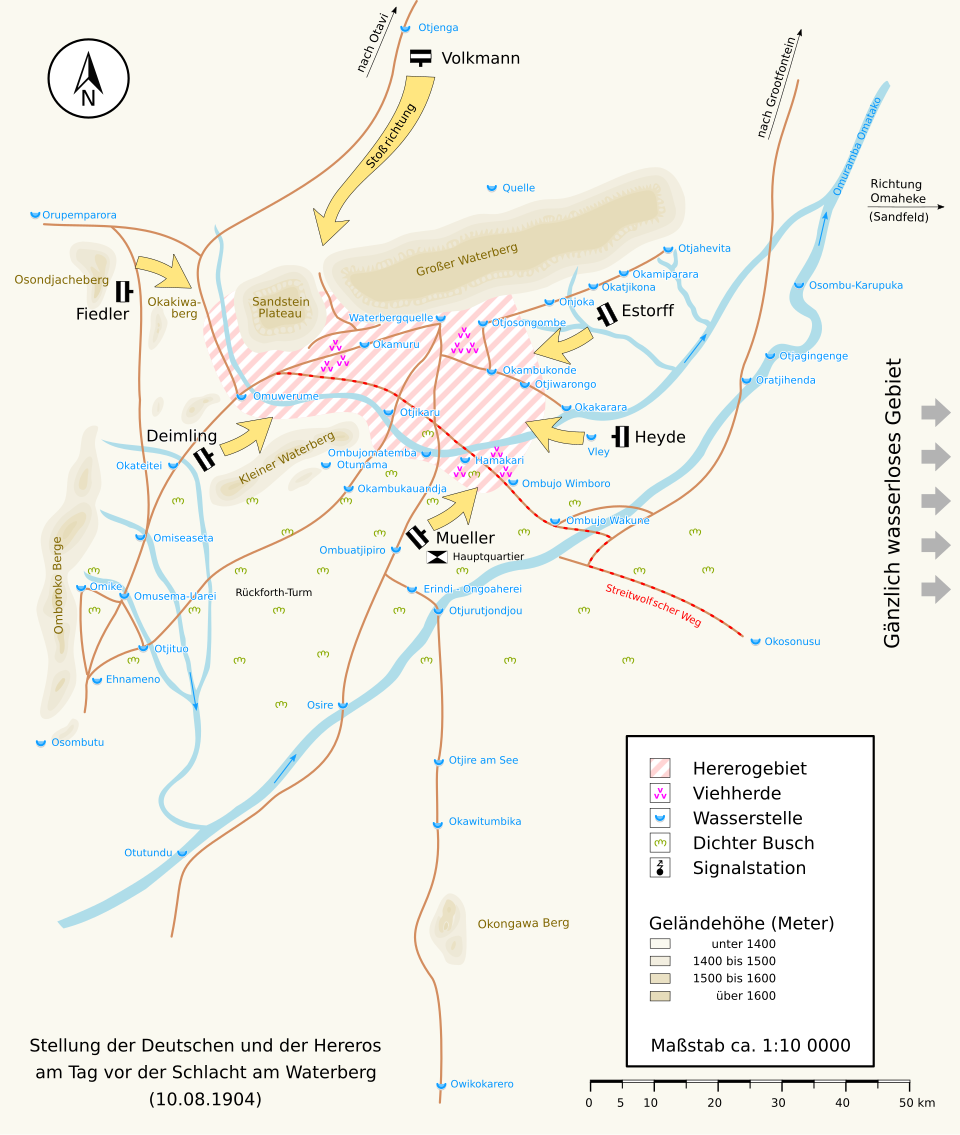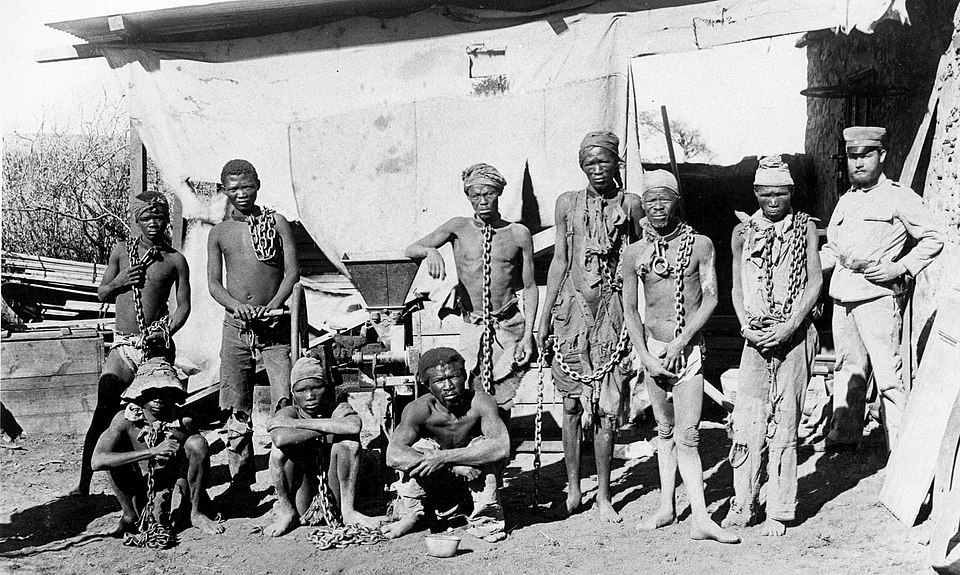IB Syllabus focus:
'Discuss the reasons for the failure of Herero and Nama resistance in Namibia and the impact of this resistance on the indigenous populations.'
In the face of European imperialism, the Herero and Nama resistance in Namibia epitomises the tragic struggle for sovereignty, marred by the overwhelming might of German colonial forces and ensuing catastrophic impacts on the indigenous populations.
Context of Resistance
Namibia's conflict with German imperialism is rooted deeply in the era's pervasive colonial aggression and the fierce indigenous responses it provoked.
German Colonisation in Namibia
Namibia was declared a German protectorate in 1884, following the Berlin Conference, which precipitated the scramble for Africa.
The German Empire implemented oppressive policies to facilitate the settlement of German nationals, who were encouraged to cultivate cash crops and raise livestock.
The Herero and Nama Peoples
Both the Herero and Nama communities were intricately tied to their land for their economic, cultural, and social survival.
Their societal structures were fundamentally disrupted by German colonial policies.
Factors Leading to the Resistance
The resistance was a complex culmination of long-standing grievances, provoked by relentless German colonisation efforts.
Expropriation of Land and Resources
Systematic land dispossession forced the Herero and Nama into unfertile areas, jeopardising their way of life.
Imposed foreign economic structures led to financial exploitation and labour abuses.
Racial Discrimination and Brutality
German colonialists imposed a regime marked by racial hierarchy and discrimination, with indigenous peoples at the bottom.
Exploitative labour practices, including forced labour, were prevalent, igniting further resentment.
Cultural and Political Disintegration
German rule sought to dismantle the traditional leadership structures of the Herero and Nama, aiming to weaken their societal cohesion.
The imposition of Christianity and Western education threatened to eradicate their cultural identity.
Outbreak of the Resistance
The resistance unfolded in waves, beginning with the Herero and followed by the Nama, reflecting deep-seated indignation against colonial rule.
The Herero Uprising (1904)
Initially a coordinated attack on German farmers, it signalled the commencement of the Herero campaign to reclaim their sovereignty.
Chief Samuel Maharero emerged as a symbol of Herero resistance, though faced internal pressures and external military challenges.
The Nama Rebellion (1904–1907)
The Nama, led by Hendrik Witbooi, utilised guerrilla tactics against the Germans, exploiting their knowledge of the arid landscape to stage ambushes and raids.
Initial Nama successes waned as German forces adapted to their tactics.
Reasons for the Failure of the Resistance
The resistance was undermined by multiple factors, contributing to its eventual collapse.
Superior German Military Technology and Tactics
The German military employed modern weapons, including machine guns and artillery, against the poorly armed Herero and Nama.
A systematic blockade strategy and the scorched-earth policy devastated the indigenous populations, cutting off access to water and vital supplies.

Plan of German dispositions and approach routes on the eve of the Battle of Waterberg (11 August 1904), indicating the intended encirclement of Herero positions and lines of advance toward the Omaheke. The map helps explain how control of water and movement corridors undermined Herero resistance. Source
Lack of International Support
The international community, preoccupied with their imperialistic interests, remained largely indifferent to the plight of the Herero and Nama.
News of the uprisings was suppressed or minimised in European press, preventing global outrage or intervention.
Disunity Among Indigenous Groups
Not all Herero and Nama groups were aligned; some chose to side with the Germans, driven by promises of protection or survival.
In-fighting and distrust between clans diluted the efforts against the common enemy.
Impact on Indigenous Populations
The aftermath of the resistance was marked by profound suffering and loss, reshaping the future of the Herero and Nama people.
The Herero and Nama Genocide
The German counter-campaign against the Herero and Nama is considered one of the first genocides of the 20th century.
Death toll estimates suggest 65,000 Herero (about 80% of the total Herero population) and 10,000 Nama (approximately 50% of their population) perished.

Prisoners from the Herero and Nama communities during the 1904–1908 war against Germany. Such images reflect the mass detentions and forced movements that accompanied the campaign. Source
Long-term Socio-economic Effects
Survivors faced a stark new reality of landlessness, economic dependency, and marginalisation.
The loss of cattle, a central element of wealth and status, led to social destabilisation and eroded traditional practices.
Demographic Changes
The Herero and Nama genocide caused a dramatic decline in the indigenous population, facilitating further German settlement.
German policies following the resistance focused on the systematic development of the colony, largely ignoring the needs and rights of the indigenous people.
Memory and Legacy
The memories of resistance and its brutal suppression have been etched into the collective memory of the Herero and Nama.
Efforts to secure recognition and reparations have been ongoing, with Germany acknowledging the genocide and promising aid, but debates about appropriate compensation persist.
Conclusion
The Herero and Nama resistance reflects the broader narrative of African resistance to European imperialism. It serves as a poignant reminder of the human cost of colonial ambitions and the enduring scars left on societies subjected to imperial domination. The events in Namibia highlight the harsh realities of colonialism, including the exploitation of indigenous peoples, the struggle for self-determination, and the catastrophic consequences of resistance in the face of overwhelming odds. This chapter in history remains a key focus for those studying the complex legacy of European imperialism in Africa.
FAQ
International diplomacy played a negligible role during the Herero and Nama resistance. The major powers, embroiled in their colonial endeavours, largely ignored the plight of the Herero and Nama. The European powers were primarily concerned with their interests and agreements, such as those solidified in the Berlin Conference of 1884. These agreements essentially carved Africa into spheres of influence with little regard for the indigenous populations. Any diplomatic efforts that might have aided the Herero and Nama were stymied by the prevailing European attitudes of racial superiority and the economic interests that took precedence over humanitarian concerns.
Notable leaders of the Herero and Nama resistance included Chief Samuel Maharero and Captain Hendrik Witbooi. Maharero was instrumental in orchestrating the 1904 uprising of the Herero people, and his leadership was a rallying point for the initial success of their resistance. Hendrik Witbooi, initially coerced into an alliance with the Germans, later emerged as a formidable leader of the Nama rebellion. His shift to resistance was significant, marking a change in tactics to guerrilla warfare. Witbooi's knowledge of the land and use of mobile guerrilla tactics made the Nama resistance particularly resilient and prolonged the conflict significantly.
The German colonial administration employed a combination of military force and strategic concessions to pacify indigenous resistance movements. Military force included brutal tactics such as the scorched-earth policy, concentration camps, and direct military campaigns designed to break the will of the resisters. Beyond force, the Germans also tried to pacify the Herero and Nama by offering peace treaties and negotiations to those willing to surrender, though often these overtures were insincere or reneged upon once the resistance weakened. These measures aimed not only to suppress active resistance but also to prevent its resurgence by dismantling social structures and disarming the population.
Germany's main objectives in colonising Namibia were rooted in the broader European pursuit of imperial expansion for economic gain, strategic advantage, and national prestige. Economically, Germany was interested in exploiting Namibia's mineral and diamond resources and establishing cash crop plantations to feed its burgeoning industry. Strategically, Namibia offered Germany a valuable foothold in Southern Africa, serving as a base for further expansion and trade. Additionally, the acquisition of colonies was a measure of national prestige during this period, and Germany was eager to establish itself as a global power on par with Britain and France.
German colonization had a profound impact on the socio-economic structures of the Herero and Nama societies. Traditional land ownership and cattle rearing, which were the bedrock of their economies and social status, were severely disrupted by German land expropriation for settler use and military campaigns. The loss of cattle to the Germans, through both seizure and destruction as a war tactic, decimated the wealth and social fabric of these communities. Moreover, the introduction of forced labour systems and other exploitative practices not only marginalised the Herero and Nama but also integrated them into the lower strata of a colonial economy, disrupting traditional livelihoods and leading to long-term socio-economic instability.
Practice Questions
The Herero and Nama resistance was significantly influenced by German military technology, which played a crucial role in the suppression of the indigenous uprisings. The disparity in firepower, with Germans wielding modern weapons such as machine guns and artillery, created an insurmountable challenge for the Herero and Nama, who were equipped with far less advanced weaponry. This technological advantage allowed the German forces to enact a scorched-earth policy, effectively cutting off the resistance's access to water and supplies, and leading to a high number of casualties, which proved decisive in the failure of the resistance movements.
The German scorched-earth policy had a devastating impact on the Herero and Nama populations. By destroying villages, poisoning wells, and seizing livestock, German forces not only dismantled the economic foundations of these societies but also inflicted dire humanitarian crises. The policy resulted in widespread famine and thirst, which, combined with the violence of war, led to catastrophic loss of life. The aftermath saw a drastic reduction in the populations, with an estimated 80% of the Herero and 50% of the Nama people perishing, marking this as one of the most tragic episodes of genocide in the early 20th century.

